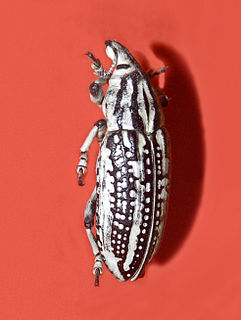Related Research Articles

Pteranodon is a genus of pterosaur that included some of the largest known flying reptiles, with wingspans over 7 meters. They lived during the late Cretaceous geological period of North America in present-day Kansas, Alabama, Nebraska, Wyoming, and South Dakota. More fossil specimens of Pteranodon have been found than any other pterosaur, with about 1,200 specimens known to science, many of them well preserved with nearly complete skulls and articulated skeletons. It was an important part of the animal community in the Western Interior Seaway.

Microtus is a genus of voles found in North America, Europe, and northern Asia. The genus name refers to the small ears of these animals. About 62 species are placed in the genus. They are stout rodents with short ears, legs, and tails. They eat green vegetation such as grasses and sedges in summer, and grains, seeds, roots, and bark at other times. The genus is also called "meadow voles".
The Zempoaltépec vole is a species of rodent in the family Cricetidae. The name Microtus is from the Greek word mikros meaning small and otus meaning ear. The name umbrosus could be from the Latin umbros meaning shady. It is rather large and has a long tail when compared with other voles. Its pelage is long and soft. In the upper parts, the hair is uniformly dusky with brown tips and the lower parts a dark grey thinly washed with a reddish yellow color. It is found only in Mexico, in a semi-isolated mountain range southeast of the Cajones River in Mixes district, in Oaxaca.

Porphyrellus is a genus of fungi of the family Boletaceae.

Xanthostemon is a genus of trees and shrubs, constituting part of the myrtle plant family Myrtaceae. This genus was first described in 1857 by German–Australian botanist Ferdinand von Mueller. According to different official sources between 46 and 51 species are known to science. They grow naturally in New Caledonia, Australia, the Solomon Islands and Malesia, including the Philippines, New Guinea and Indonesia. The genera Pleurocalyptus and Purpureostemon from New Caledonia are morphologically close to Xanthostemon.

Arvicolini is a tribe of voles in the subfamily Arvicolinae.

Apateon is an extinct genus of temnospondyl amphibian within the family Branchiosauridae.
Plasmodium traguli is a parasite of the genus Plasmodium subgenus Vinckeia. As in all Plasmodium species, P. traguli has both vertebrate and insect hosts. This particular species infects mouse deer in Southeast Asia.
Pseudometapterus umbrosus is a species of assassin bug found in North America. It is univoltine in Illinois and overwinters as an adult. It has been reported from spider webs and plants on sandstone and limestone bluffs. The vast majority of observed individuals are mictropterus, but in 2000, a macropterus female was observed in Little Grand Canyon, Jackson County, Southern Illinois.

Urticicola is a genus of air-breathing land snails, terrestrial pulmonate gastropod mollusks in the family Hygromiidae, the hairy snails and their allies.
Rhodoleptus is a genus of beetles in the family Cerambycidae, containing the following species:
Leptocometes is a genus of beetles in the family Cerambycidae, containing the following species:

Liocleonus is a genus of cylindrical weevils belonging to the family Curculionidae.
Oricopis is a genus of longhorn beetles of the subfamily Lamiinae, containing the following species:
Oricopis umbrosus is a species of beetle in the family Cerambycidae. It was described by Francis Polkinghorne Pascoe in 1863. It is known from Australia.
Xanthostemon umbrosus is a tree species in the family Myrtaceae that is endemic to Australia.

Pareques is a genus of fish of the family Sciaenidae in the order of the Perciformes.
Margarinotus umbrosus is a species of clown beetle in the family Histeridae. It is found in Western North America, from central California to British Columbia in the north and eastward to Montana and Alberta. It has been recorded from dung, carrion, and decaying vegetation.
Atrazonotus is a genus of dirt-colored seed bugs in the family Rhyparochromidae. There is one described species in Atrazonotus, A. umbrosus.
Aspergillus umbrosus is a species of fungus in the genus Aspergillus. It is from the Aspergillus section. The species was first described in 1912. It has been reported to produce asperflavin, auroglaucin, bisanthrons, dihydroauroglaucin, echinulins, emodin, epiheveadrides, erythroglaucin, flavoglaucin, isoechinulins, neoechinulins, physcion, questin, questinol, tetracyclic, and tetrahydroauroglaucin.
References
- ↑ J. D. Bradshaw and J. E. McPherson. "Discovery of Macroptery in Pseudometapterus umbrosus (Heteroptera: Reduviidae)" (PDF). Florida Entomologist 84(4) December 2001.
| | This Cimicomorpha article is a stub. You can help Wikipedia by expanding it. |